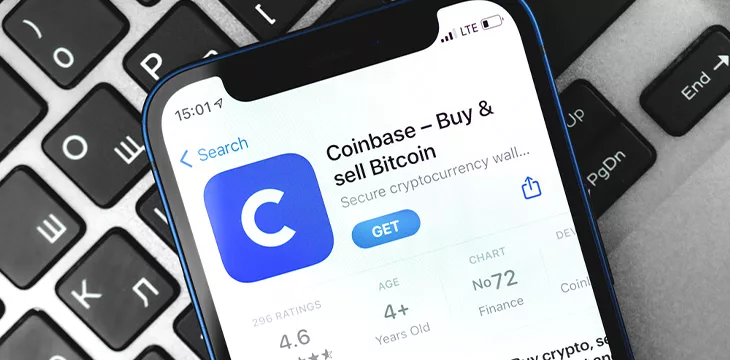|
Getting your Trinity Audio player ready...
|
Coinbase (NASDAQ: COIN) is trying to rally support for reducing regulatory oversight of its operations, even as U.S. regulators warn that additional oversight is on the way.
On Tuesday, the digital asset exchange issued a ‘call to action’ aimed at mobilizing what it claims are the 52 million Americans who own some form of ‘crypto.’ The exchange wants these minions, er, millions to call their congressperson on September 27, the Coinbase-designated ‘Stand with Crypto Day,’ to convince Congress to pass “clear, sensible legislation” on digital assets.
Coinbase wants callers to put “intense focus” on politicians in nine states—AZ, CA, GA, IL, NH, NV, OH, PA, and WI—and the Georgia effort is weirdly focused on building “a club of crypto of at least 11,779 members.” We can’t help but notice that is exactly one more than the 11,780 votes former President Donald Trump asked Georgia’s Secretary of State to “find” to flip the state’s 2020 presidential election results. Is the exchange road-testing a new ‘Make Coinbase Great Again’ slogan? Is Coinbase CEO Brian Armstrong about to crown his bald head with an epic blonde weave?
Rug or rug-pull, whatever Coinbase is planning, it doesn’t seem to be working. Armstrong recently tweeted his irritation at the U.S. Commodity Futures Trading Commission (CFTC) having taken action against three ‘decentralized finance’ (DeFi) platforms (Opyn, ZeroEx and Deridex).
The three platforms failed to clear a number of regulatory hurdles, leading CFTC enforcement director Ian McGinley to muse that “DeFi operators got the idea that unlawful transactions become lawful when facilitated by smart contracts. They do not.”
Armstrong said the CFTC “should not be creating enforcement actions against” DeFi protocols and expressed the hope that the three entities “take these cases to court to establish precedent.” Armstrong appears to have only a single arrow left in his quiver, which is to insist that any regulatory action involving digital assets is illegal, a strategy that has so far failed to win his exchange any favors (or court victories).
And worse is undoubtedly in the pipeline. The CFTC’s McGinley said this week that unregulated DeFi “is an obvious threat to the markets” that the agency isn’t taking lightly. Meanwhile, David Hirsch, the head of the Crypto Assets and Cyber Unit at the Securities and Exchange Commission (SEC), said this week that “adding the label of DeFi is not going to be something that’s going to deter us” from investigating and prosecuting bad actors.
The SEC is currently embroiled in several high-profile civil suits against exchanges like Binance and Coinbase for offering unregistered securities to customers. Hirsch acknowledged that some of the entities the SEC is suing have bigger budgets but the agency would “continue to conduct investigations. We’re gonna be active in the space.”
Jerome Powell to the rescue
The choppy waters ahead for DeFi are discordant music to Armstrong’s ears, given the high hopes Coinbase has for Base, the company’s new Ethereum ‘layer 2’ network. Coinbase has specifically pitched Base as the new home for developers looking to launch decentralized apps, so there must be alarm within Coinbase’s C-suite at the realization that regulators could strangle this revenue infant in its cradle.
And make no mistake, Coinbase needs every dime of revenue it can generate. Its most recent quarterly report showed a net loss of $97 million, marking the sixth straight quarter of negative profits. Perhaps that’s why Coinbase still hasn’t returned the $1 million in transaction fees its Ethereum validator operations generated from the recent Curve exploit.
Oh, and those expanding legions of retail customers that Coinbase claims to represent on the political front? Coinbase’s monthly transacting customers—with ‘transaction’ broadly defined to include passive income recipients—fell by 13% from Q1 to Q2. And the few that remained active traded one-third less volume over that same span.
Wednesday’s news that the U.S. Federal Reserve would likely raise interest rates once more before the year is over and keep them higher through 2024 was likely greeted with huzzahs from Coinbase’s executive ranks. With trading volume stagnant, Coinbase is increasingly reliant on interest on the reserves backing USDC, the stablecoin issued by Circle, Coinbase’s former partner in the now-defunct Centre consortium.
Amid fears that the company’s best days are behind it, Coinbase recently embarked on an effort to buy up its long-term debt for pennies on the dollar. Coinbase originally offered to buy up to $180 million of its debt maturing in 2031 for 64.5¢ on the dollar, but found takers for only around $50 million at that price, forcing Coinbase to up its offer to 67.5¢.
On Tuesday, Coinbase announced that an additional $212.5 million of its 2031 notes had been accepted at this new rate, bringing the total value to $262.5 million. There’s two ways to read this result: either there’s a lot of hard-pressed investors who just need all the cash they can find right now, or few believe Coinbase will be around in 2031 to make good on its obligations.
Go broad, go meek
Armstrong made major waves earlier this year when he declared that U.S. regulators’ objections to Coinbase running wild would accelerate the company’s international expansion efforts, “including relocating or whatever is necessary.” (This, despite Coinbase deriving around 85% of its revenue from U.S. customers.)
Coinbase has displayed significantly less regulatory petulance abroad, including this month’s announcement that its Singapore customers would need to submit additional counterparty information when receiving deposits from outside Coinbase or withdrawing to something other than a Coinbase Wallet. Coinbase said the restrictions were to comply with Monetary Authority of Singapore regulations. (See, that wasn’t so hard!)
That was followed by Coinbase disabling new customer sign-ups in India, while some locals were told to move their funds off the exchange completely by September 25. Without providing specifics, TechCrunch reported that these targeted users “didn’t meet the company’s updated standards.” Coinbase eventually declared that it remains “committed to India over the long term” and continues to offer “live products,” including Coinbase Wallet, in the country.
Sensor Tower data showed that Coinbase currently has fewer than 50,000 monthly active customers in India. But with India containing nearly one-fifth of the world’s population, Coinbase clearly doesn’t want to annoy the local government any more than it already has.
Armstrong stuck his foot in it last year by announcing that Indian customers could easily fund their Coinbase accounts via the country’s Unified Payments Interface (UPI), only to have the bureau that oversees that system declare that it hadn’t given any exchange permission to access the UPI. After which Coinbase beat a hasty and ignominious retreat.
Tellingly, Armstrong has yet to unleash the kind of verbal tirades and absolutist rhetoric toward India’s hardnosed regulators that their U.S. counterparts have been subjected to in recent years. It’s almost as if he understands that nobody in the U.S. takes his tantrums seriously anymore, or that his operations are far more fragile abroad and thus he needs to use his ‘indoor voice.’
Back to the future
Searching for potential new revenue streams is at the core of Armstrong’s recent blog post promoting the inaugural Coinbase Ventures Summit in Los Angeles next month. Coinbase’s VC arm hopes to chew the fat with select ‘builders’ with the possibility that Coinbase Ventures “may ultimately fund some of the companies who attend, or are formed, as a result of the Summit.”
And hey, if your wacky crypto project comes with a bespoke token—and there’s always a token—you can be sure that Armstrong will list it for trading on Coinbase. And then feign ignorance when asked how that listing decision was made.
Armstrong’s blog laid out a list of 10 “startups I would build today” if he wasn’t so busy trying to keep Coinbase from going under. Among these revolutionary spitballs is the concept of a ‘flatcoin,’ aka a stablecoin alternative that’s backed not by any single fiat currency, but “by a basket of assets to track [consumer price index], or use an algorithmic approach.”
That’s right. In case you fiscal masochists didn’t get enough from the algorithmic stablecoin debacle that was Terraform Labs, Armstrong thinks he’s got just what you’re after. Never mind that UST’s collapse sparked the never-ending ‘crypto winter’ that robbed Coinbase of whatever mojo it once had; once more unto the breach!
Armstrong also suggested he’d welcome a return of the 2017 initial coin offering (ICO) pump-and-dump frenzy, albeit with a few more guardrails to prevent what the understated Armstrong called “some major challenges” of the previous era. Rebranded as ‘onchain capital formation,’ Armstrong thinks ICOs could ‘democratize’ fundraising and thus “unlock tremendous latent entrepreneurial energy across the world.”
Does anyone else get the sense that Armstrong wants to turn back the clock to a time when ‘crypto bros’ walked tall and the skies were not cloudy all day? Having turned 40 years old in January, he’s probably starting to feel his age, his knees creaking, his back aching, his hair thinning… (Okay, scratch that last one.)
Which got us thinking… Armstrong’s former peer Sam Bankman-Fried (SBF), founder of the bankrupt FTX exchange, is currently in the Manhattan Detention Center awaiting his criminal trial on charges of fraud and money laundering. SBF recently made headlines because MDC wasn’t supplying him with his usual dose of methamphetamine, er, Adderall.
For the record, we have no idea what may or may not be currently coursing through Armstrong’s veins. But we will say this: nostalgia’s one hell of a drug.
Follow CoinGeek’s Crypto Crime Cartel series, which delves into the stream of group—from BitMEX to Binance, Bitcoin.com, Blockstream, ShapeShift, Coinbase, Ripple,
Ethereum, FTX and Tether—who have co-opted the digital asset revolution and turned the industry into a minefield for naïve (and even experienced) players in the market.

 07-18-2025
07-18-2025 





